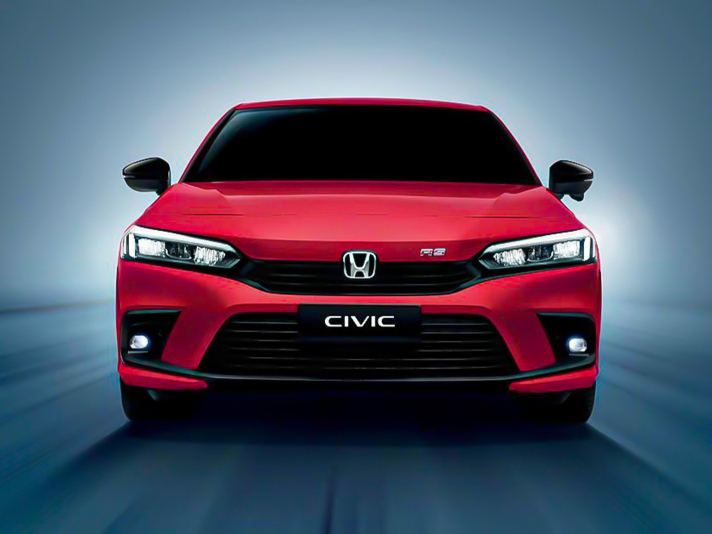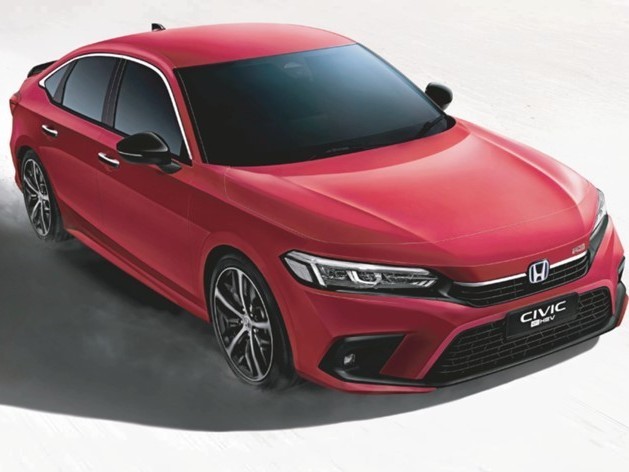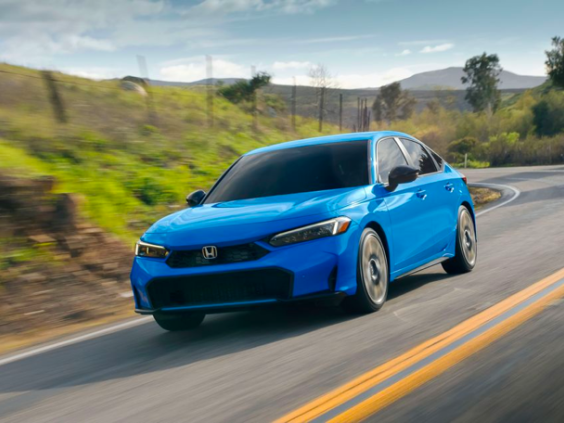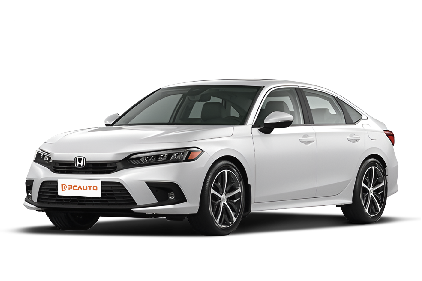Q
How Heavy Is Honda Civic? Check Here to Know
The weight of the Honda Civic varies depending on different models and configurations. For the 2025 models, the 1.5L E version weighs 1,338 kilograms, the 1.5L V version weighs 1,349 kilograms, the 1.5L RS version weighs 1,362 kilograms, and the 2.0L e:HEV RS version weighs 1,445 kilograms. The weights of the older models are also different. For example, among some models of the 2023 version, the 1.5L E version weighs 1,338 kilograms and the 1.5L V version weighs 1,349 kilograms.
Generally speaking, its weight ranges from a little over 1,200 kilograms to over 1,400 kilograms. The difference in weight can affect various aspects of the car. A heavier Civic may offer better stability, especially when driving at high speeds or making sudden turns, and it may provide more protection in the event of a collision. Lighter models may be more fuel - efficient and accelerate faster.
Special Disclaimer: This content is published by users and does not represent the views or position of PCauto.
Related Q&A
Q
What Segment Does Honda Civic Belong to?
The Honda Civic belongs to the C-Segment, which is in the compact car category. Compact cars typically have a body length ranging from 4.2 to 4.6 meters, focusing on being price - friendly, fuel - efficient, and convenient for daily use, with a design that balances practicality and driving pleasure.
The Honda Civic has a body length of about 4.6 meters. This size ensures ample interior space and handling flexibility. It offers a variety of power options, from naturally - aspirated to turbocharged engines, which can meet the needs of different consumers. The body design emphasizes aerodynamics and a modern look. With a young and stylish appearance, it's suitable for urban commuting and family trips. In the market, the Civic's direct competitors usually include other compact cars in the same class, such as the Toyota Corolla, Volkswagen Golf, Mazda 3, and Hyundai Elantra.
Q
What Is the Reslae Value of Honda Civic?
The Honda Civic maintains strong resale value in the used car market, consistently ranking among the best-retaining Japanese sedans in its class , particularly the newer tenth-generation (FC) and eleventh-generation (FK) models. Industry data shows Civic typically depreciates only 20%-30% over the first three years (depending on condition, mileage and market demand). For example, a 2020 Civic 1.5 TC originally priced around RM130k can still be priced at RM90k-RM100k in today's used market (varying by trim and maintenance history).
This exceptional value retention benefits from Honda's brand reputation, the appeal of its turbocharged engine (1.5L VTEC Turbo), and relatively low maintenance costs - though the base 1.8L naturally aspirated versions fetch slightly lower (yet still competitive) prices. Generally, low-mileage examples (under 15,000km annually) with complete service records and accident-free history are the most popular, while higher trims with Honda Sensing (like 1.5 TC-P) command premium resale prices over standard versions.
Additional factors affecting resale value include: preferred colors (white/gray being most popular), remaining factory warranty coverage, and aftermarket modifications (which may actually decrease value). Owners are advised to maintain regular authorized service center visits and keep complete documentation to maximize future resale potential.
Q
What's the Engine Displacement of Honda Civic?
The Honda Civic provides a variety of models with different displacements. The common displacements are 1.5L and 2.0L. When converted to CC (cubic centimeter, where 1L = 1000CC), they correspond to 1498CC and 1993CC respectively. The 1.5L models generally adopt the turbo - charged intake form, offering a fairly abundant power output, which can meet the needs of daily driving and some scenarios with certain power requirements. The 2.0L e:HEV RS model, on the other hand, is a gasoline - electric hybrid (HEV). It combines the advantages of the engine and the electric motor. While providing good power, it also boasts excellent fuel economy. Each model with different displacements has its own characteristics, and consumers can make a choice based on their own needs and preferences.
Q
What Engine Is Equipped by Honda Civic?
The Honda Civic offers multiple engine configurations. A common option is the 1.5L Turbo engine, featuring turbocharged intake with a displacement of 1498mL. It delivers a maximum horsepower of 182PS (134kW) at 6000rpm and peak torque of 240N·m between 1700-4500rpm. This inline-4 cylinder engine adopts an L-type cylinder arrangement.
Another available configuration is the 2.0L e:HEV RS, which utilizes naturally aspirated (NA) intake with a 1993mL displacement. The combustion engine produces 143PS (105kW) at 6000rpm and 189N·m of torque at 4500rpm. Combined with its electric motor, the hybrid system generates an additional 184PS (135kW) and 315N·m of torque.
These different engine options cater to varying consumer needs and driving preferences. The 1.5L Turbo provides robust power output, appealing to performance-oriented drivers, while the 2.0L e:HEV RS hybrid configuration balances adequate power delivery with superior fuel efficiency.
Q
What Is the Gearbox Type of Honda Civic?
The gearbox types of the Honda Civic vary depending on the model and year. Common transmission types include Continuously Variable Transmission (CVT) and Electronically Controlled Continuously Variable Transmission (E - CVT).
For gasoline - powered Honda Civic models, such as the 2025 Honda Civic 1.5L E, 1.5L V, and 1.5L RS, they are equipped with CVT. This type of transmission can provide a smooth driving experience and help optimize fuel efficiency. Unlike traditional transmissions, CVT doesn't have distinct gears and can achieve seamless changes in the transmission ratio according to driving conditions.
The 2025 Honda Civic 2.0L e:HEV RS is a gasoline - hybrid model, which uses E - CVT. This is specifically designed for hybrid vehicles. It combines the power of the engine and the electric motor, further improving fuel economy and providing a refined driving experience. The E - CVT manages the power distribution between the two power sources to ensure efficient operation in different driving scenarios.
Q
What Is the Pitch Circle Diameter of Honda Civic?
PCD (Pitch Circle Diameter) refers to the diameter of the central circle of the bolt holes in an automobile wheel hub. The PCD sizes of Honda Civic vary across different years and versions. Although the PCD dimensions may vary across different model years and versions of the Honda Civic, the given information does not explicitly specify the PCD. However, based on common wheel bolt-hole references for models like the 2022–2025 Civic, which have various tire sizes (e.g., 215/55 R16, 215/50 R17, 235/40 ZR18), the PCD in the Malaysian automotive market is typically 5x114.3mm—a widely compatible size.
For precise measurements, it is recommended to consult Honda authorized dealers or professional automotive workshops, as they can provide accurate PCD specifications for specific vehicle models.
Q
Is Honda Civic Equipped with Apple Carplay?
The currently available 11th-generation Honda Civic (Honda Civic 2023 FK) comes standard with Apple CarPlay wireless connectivity across the whole range (wired connection may also be retained in some models). Paired with a 9 - inch high - definition touchscreen, it seamlessly integrates navigation, music, and call operations for iPhone users.
As for the previous 10th - generation Civic (FC models), the mid - cycle facelift versions after 2019 (some 1.5 TC/TC - P models) also started to introduce Apple CarPlay. However, it should be noted that the early FC versions from 2016 - 2018 only support the Honda original system. If you want CarPlay, you may need to install a third - party module by yourself.
It is recommended that before buying a car, you confirm whether the function is available through the "Smartphone Connection" icon in the upper - right corner of the in - car screen or check the voice command button (with a microphone icon) on the steering wheel. If you're buying a used car, you can ask to test the compatibility by connecting your phone.
In addition, Honda Malaysia has been actively upgrading the in - car system in recent years. The new - generation Civic supports wireless Android Auto and maintains stable compatibility with the iOS system (it is recommended to use iOS 14 or later). In the future, system updates may further optimize the connection stability and response speed.
Q
What Is the Brand of Honda Civic's Tire?
The original - equipped tire brands adopted by the Honda Civic vary depending on different model years, vehicle types, and regional dealerships. Commonly, they include Michelin (such as Primacy 4 or Pilot Sport 4), Yokohama (like Advan dB or BluEarth - GT), and Bridgestone (Turanza T005A). These tires are characterized by their quietness, wear resistance, and wet - grip performance, which align with Honda's positioning for the Civic's well - balanced performance.
For example, the high - end 1.5 TC - P model might come with the higher - performance Michelin Pilot Sport series, while the entry - level 1.8S could be paired with more economy - oriented Yokohama tires. It's recommended that owners check the markings on the tire sidewall to confirm the specific model (e.g., 215/50 R17).
In addition, vehicles from different batches may have their tire brands changed due to supply - chain adjustments. If owners have higher requirements for the performance of the original tires, they can consult the authorized service center during maintenance or upgrade the tires on their own (such as choosing Continental or Goodyear). However, it's important to note that the tire size and load index must match the original specifications (most FK5 - generation models use 215/50 R17 or 235/40 R18) to ensure driving safety and maintain warranty rights.
Q
Is Honda Civic a Good Car? Learn the Pros and Cons Here
The Honda Civic is generally regarded as a good car with both advantages and disadvantages. Regarding its advantages, it has good performance. Some models are equipped with turbocharged engines, which can offer a pleasant acceleration experience. For example, the models equipped with a 1.5 - liter turbocharged engine can reach a maximum speed of 200 kilometers per hour. Its fuel economy is also quite good. The official combined fuel consumption of some models is about 6 liters per 100 kilometers, which helps to save the usage cost.
In terms of handling, the Civic benefits from its well - tuned suspension. The combination of the MacPherson front suspension and the multi - link rear suspension can provide a stable driving and riding experience and sensitive handling performance whether on city streets or highways. Safety performance is also one of its highlights. It comes standard with a series of safety features, such as multiple airbags, Anti - lock Braking System (ABS), and Electronic Stability Control, making you feel more secure on the road. The interior design is user - friendly, and the overall workmanship quality is usually reliable.
However, it also has some drawbacks. Some drivers may find the noise level, especially the road noise and wind noise at high speeds, a bit annoying. The rear - seat space may seem a bit cramped for taller passengers. In addition, compared with some competitors, its price may be relatively high. But overall, if you value performance, safety, and handling more than an absolutely quiet interior environment and the largest rear - seat space, then the Honda Civic is a good choice.
Q
What Is the Width of Honda Civic?
The width of the Honda Civic varies depending on different models and generations. Generally speaking, for the models listed here, the Honda Civic has a width of 1,802 millimeters. This dimension affects the vehicle's overall footprint on the road, affecting stability while driving, the space it takes up in parking lots and so on. It also has an impact on the interior space available to passengers. The wider the body, the more shoulder and elbow room passengers may have. Keep in mind that these dimensions may vary for newer or different versions of the Honda Civic.
Latest Q&A
Q
Is Challenger 2 seater or 4 seater?
As a classic American muscle car, the seating configuration of the Challenger depends on the specific model version. Take the Dodge Challenger, which is quite common in the Malaysian market, as an example. The standard version of this car features a 2+2 four-seat layout (two full-sized seats in the front row plus two smaller seats in the rear row). However, high-performance versions like the SRT Hellcat may remove the rear seats and adopt a pure two-seat design to reduce the vehicle's weight.
Malaysian consumers should note that there may be differences in the configurations of imported models with different production years and displacements. It is recommended to confirm the specific specifications through local authorized dealers.
It's worth noting that this type of American muscle car is a niche model in Malaysia. Its wide body size (with a length of over 5 meters) requires some adaptation when driving on local narrow roads. Nevertheless, the powerful sound of the V8 engine and its classic styling still attract many car enthusiasts.
If practicality is a major consideration, SUV models like the Durango from the same brand are more suitable for family use. On the other hand, the Challenger is more suitable for enthusiasts who pursue the American-style sentiment and the experience of straight-line acceleration.
Q
What are the disadvantages of a Dodge Challenger?
The Dodge Challenger, as a classic American muscle car, has unique charm in terms of power performance and design style. However, it also has some limitations in the Malaysian market. First of all, its large-displacement engines (such as the 5.7L or 6.4L HEMI) result in high fuel consumption. In an environment where fuel prices in Malaysia fluctuate greatly, this may increase the cost of use. At the same time, the emission standards may also face stricter compliance requirements. Secondly, with a length of over 5 meters and a relatively wide wheelbase, it has poor flexibility on narrow roads or in old-style parking lots in cities like Kuala Lumpur. It is not as convenient as compact cars for daily commuting. In terms of interior space, although the front row is spacious, the rear-seat legroom is relatively cramped, making it more suitable for two passengers. In addition, as an imported vehicle, its parts supply cycle is long and the maintenance cost is higher than that of locally assembled models. Also, special attention should be paid to the performance of the factory-configured summer tires on wet roads in Malaysia's rainy climate. It's worth noting that the suspension tuning of American muscle cars is on the stiffer side, which may affect comfort in some areas of Malaysia with poor road conditions. However, for car enthusiasts who pursue personalization and the sound of a V8 engine, these features may also be regarded as part of its unique charm. It is recommended that potential buyers weigh their needs according to their actual usage scenarios.
Q
Is a Challenger an everyday car?
As a classic American muscle car, the Dodge Challenger was originally designed with a greater emphasis on performance and driving pleasure rather than daily commuting. However, it can still be used as a daily vehicle in specific usage scenarios in Malaysia. This car is equipped with large-displacement HEMI V8 engines (such as the R/T or Hellcat versions), which offer powerful performance but come with high fuel consumption. It may not be very cost-effective in congested areas like Kuala Lumpur. Nevertheless, the 3.6L V6 version (such as the SXT) has relatively better fuel efficiency, making it more suitable for daily driving.
The chassis of the Challenger is tuned to be on the stiffer side, which is well-suited to the good highway conditions in Malaysia. But when it comes to the old urban roads, the ride comfort will be reduced. In terms of interior space, the four-seat design can meet the needs of small families, and the trunk has a volume of up to 462 liters, making it more practical than many sports cars.
It's worth noting that in Malaysia's hot climate, special attention should be paid to mechanical heat dissipation. Moreover, the right-hand-drive version can only be obtained through parallel imports, and the maintenance cost will be higher than that of ordinary Japanese cars. If you have a sufficient budget and prefer the American style, the unique styling and exhaust sound of the Challenger can definitely turn a lot of heads. However, if you're looking for practicality at the same price, you can also consider Japanese performance sedans or European hot hatches. When making a choice, it is recommended to weigh the actual commuting distance and road conditions. After all, the charm of a muscle car lies in unleashing its wildness rather than compromising for daily use.
Q
Are challengers fuel efficient?
As a classic American muscle car, fuel economy isn't the main selling point of the Dodge Challenger. Especially in the V6 or V8 engine versions commonly seen in the Malaysian market, the urban fuel consumption is about 12-15 liters per 100 kilometers, and it can drop to 9-11 liters per 100 kilometers during highway cruising. This is slightly higher compared to Japanese or European performance cars in the same class, but it aligns with its emphasis on large-displacement power output and retro design concept.
If you're considering fuel efficiency, you can focus on the SXT version equipped with a 3.6L Pentastar V6 engine, or choose options like the rear-axle differential and active exhaust to improve highway cruising efficiency. Malaysian consumers should note that this type of American car is more suitable for long-distance driving or for collectors. If you commute frequently and care about fuel consumption, you can also compare local popular hybrid models such as the Toyota Camry Hybrid or the Honda City RS, which can optimize fuel performance while maintaining power.
When making an actual choice, it's advisable to consider your own driving habits and fuel budget, and take a test drive to experience the unique driving feel and the charming engine roar of an American muscle car.
Q
Do challengers last long?
The Dodge Challenger, a classic American muscle car, performs quite reliably in terms of durability. Especially its V8 engine versions like the Hellcat or Demon, with their robust mechanical structures and mature powertrain technologies, can run for a long time under proper maintenance. The climate in Malaysia is hot and humid. It's recommended that car owners pay special attention to the regular inspection of the cooling system and rubber parts. Meanwhile, choose engine oil and coolant suitable for the tropical climate to extend the vehicle's lifespan. American cars generally focus on low-speed and high-torque tuning, which is suitable for the stop-and-go traffic conditions in Malaysia, but they consume relatively more fuel. If you're considering long-term ownership, it's advisable to check whether the local after-sales network is well-established and if the supply of spare parts is sufficient. In fact, the durability of any vehicle highly depends on maintenance habits. Regularly replacing key components such as the timing belt and transmission fluid is crucial. For users who love muscle cars but are worried about maintenance costs, they can also consider Japanese performance cars like the Toyota Supra or the Nissan Z series, as their adaptability in tropical regions has been proven over a longer period.
View MoreRelated News

Honda Civic Interior Revealed: A Comprehensive Analysis of Civic’s Interior Charm
Kevin WongJul 10, 2025

Honda Civic Price Revealed: The Most Detailed Buying Guide!
AshleyApr 8, 2025

Whether it's about appearance or handling, why do young people all like Honda Civic?
WilliamSep 24, 2024

2022 Honda Civic: Hybrid car with the fastest acceleration, lowest fuel consumption, who says eco-friendly cannot be fast
JohnSep 3, 2024

2025 Honda Civic debuts, minor changes in appearance, has 1.5 Turbo model been discontinued?
LienMay 22, 2024
View More













 Cars
Cars




Pros
Cons